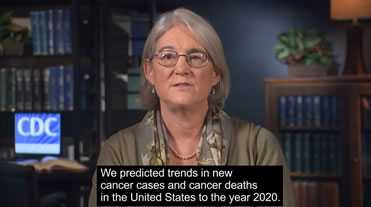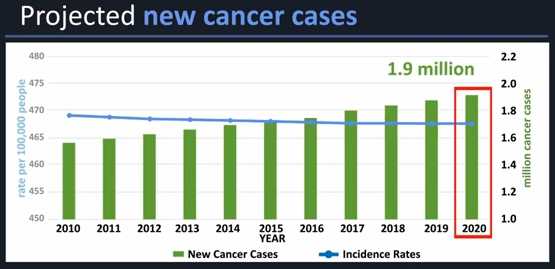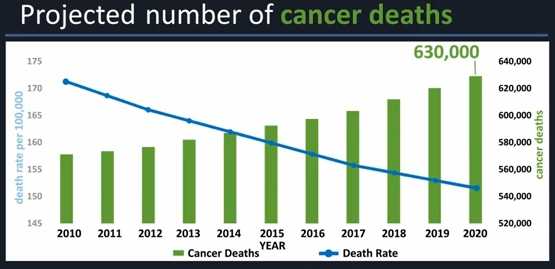Expected New Cancer Cases and Deaths in 2020
New Cancer Cases

In this video abstract, CDC’s Dr. Hannah Weir talks about her work to project trends in new cancer cases and deaths to the year 2020. Rates for many cancers are decreasing or stabilizing, but the number of cancer cases and deaths will continue to increase.
Between 2010 and 2020, we expect the number of new cancer cases in the United States to go up about 24% in men to more than 1 million cases per year, and by about 21% in women to more than 900,000 cases per year.
The kinds of cancer we expect to increase the most are—
- Melanoma (the deadliest kind of skin cancer) in white men and women.
- Prostate, kidney, liver, and bladder cancers in men.
- Lung, breast, uterine, and thyroid cancers in women.
Over the next decade, we expect cancer incidence rates to stay about the same, but the number of new cancer cases to go up, mostly because of an aging white population and a growing black population. Because cancer patients overall are living longer, the number of cancer survivors is expected to go up from about 11.7 million in 2007 to 18 million by 2020.
Why Some Kinds of Cancer Are Expected to Increase
Cigarette smoking is linked to many kinds of cancer, especially lung cancer. In the United States, smoking has declined since the first Surgeon General’s Report on Smoking and Health was published in 1964. Accordingly, new cases of lung cancer have gone down since the mid-1980s in men and the late 1990s in women—faster in men than women. The number of new lung cancer cases in men is expected to stay the same between 2010 and 2020, but more than 10,000 additional new lung cancer cases are expected to be found in women each year by 2020.
Overweight and obesity raise risk for female breast, colorectal, esophageal, uterine, pancreas, and kidney cancers. After increasing over the past several decades, about two-thirds of adults and one-third of children are now overweight or obese. Except for breast and colorectal cancers, the number of weight-related cancers is expected to go up 30% to 40% by 2020.
Cancers caused by infections are also expected to increase. New cases of liver cancer are expected to go up more than 50%, likely the result of the increase in hepatitis infections, particularly in people born between 1945 and 1965. Oral cancers in white men are expected to increase by about 30%, likely the result of more human papillomavirus (HPV) infections.
Cancer Deaths
Between 2007 and 2020, the number of deaths is expected to go up 15.2% in men and 8.1% in women, although the rate of cancer deaths per 100,000 people in the United States is expected to keep going down. We expect cancer death rates to drop most for—
- Prostate cancer (26.4%).
- Colorectal cancer (23.4%).
- Lung cancer (21.3%).
- Female breast cancer (19.6%).
- Cancers of the oral cavity and pharynx (16.0%).
- Cervical cancer (12.5%).
- Melanoma (7.4%).
Between 1975 and 2009, the number of cancer deaths went up in both white and black Americans, mostly because of an aging white population and a growing black population. The cancer death rate began to drop in the early 1990s, mostly because of a decline in deaths from lung and prostate cancer in men, breast cancer in women, and colorectal cancer in both sexes.
Why Deaths from Some Kinds of Cancer Are Expected to Drop
Fewer white women are expected to die from breast, cervical, and colorectal cancer because more white women are getting screened for these cancers, and because of better treatments. More access to high-quality health care has led to increased survival and fewer deaths for colorectal cancer, and to a lesser extent for female breast cancer and prostate cancer.
Citations
Weir HK, Thompson TD, Soman A, Møller B, Leadbetter S, White MC. Meeting the Healthy People 2020 objectives to reduce cancer mortality. Preventing Chronic Disease 2015;12:140482.
Weir HK, Thompson TD, Soman A, Møller B, Leadbetter S. The past, present, and future of cancer incidence in the United States: 1975 through 2020. Cancer 2015;121(11):1827–1837.
Projected New Cancer Cases and Deaths, 2010 Through 2020

This graph shows that the number of new cancer cases is expected to increase from about 1.5 million per year in 2010 to 1.9 million per year in 2020, although the rate of people who get cancer is expected to stay about the same.

This graph shows that the number of cancer deaths is expected to increase from about 575,000 per year in 2010 to 630,000 per year in 2020. However, the rate of people who die from cancer is expected to decrease from about 171 per 100,000 people in 2010 to 151 per 100,000 people in 2020.
- Page last reviewed: June 24, 2015
- Page last updated: March 23, 2016
- Content source:
- Maintained By:


 ShareCompartir
ShareCompartir